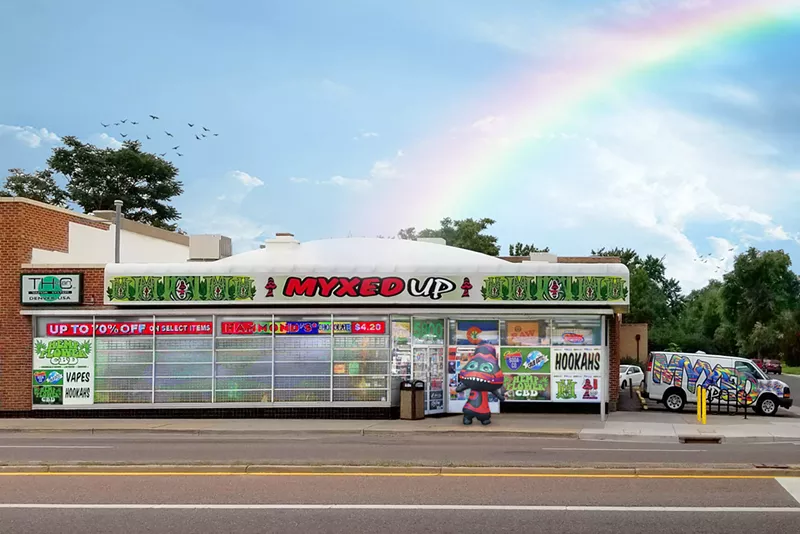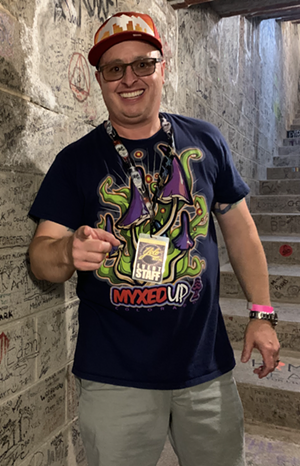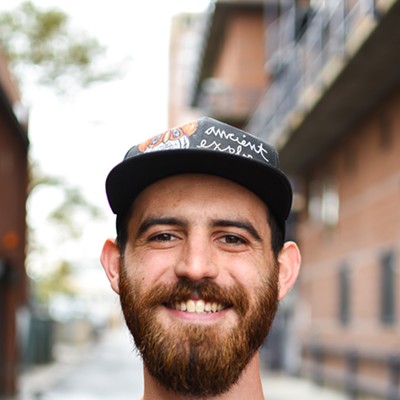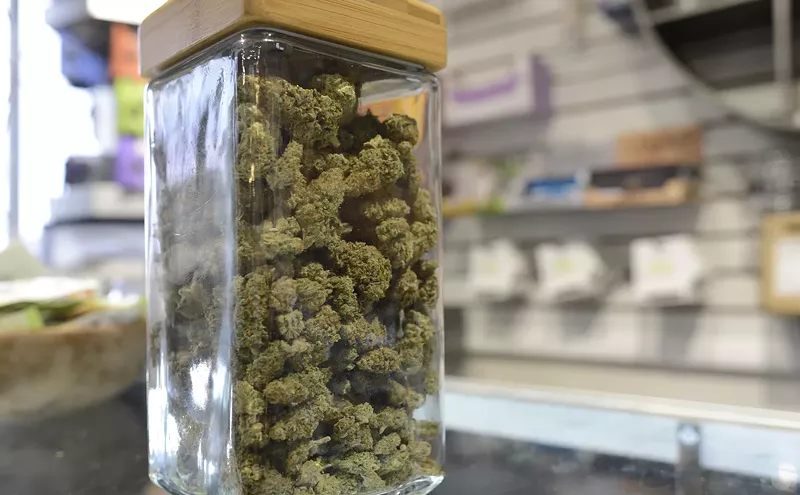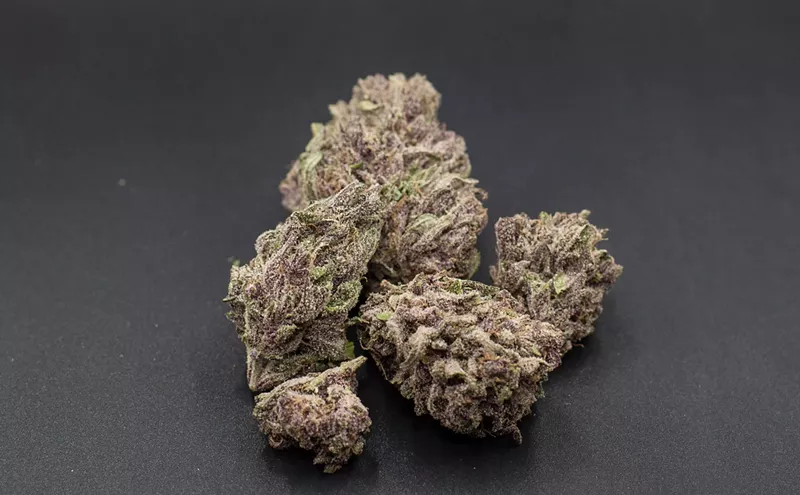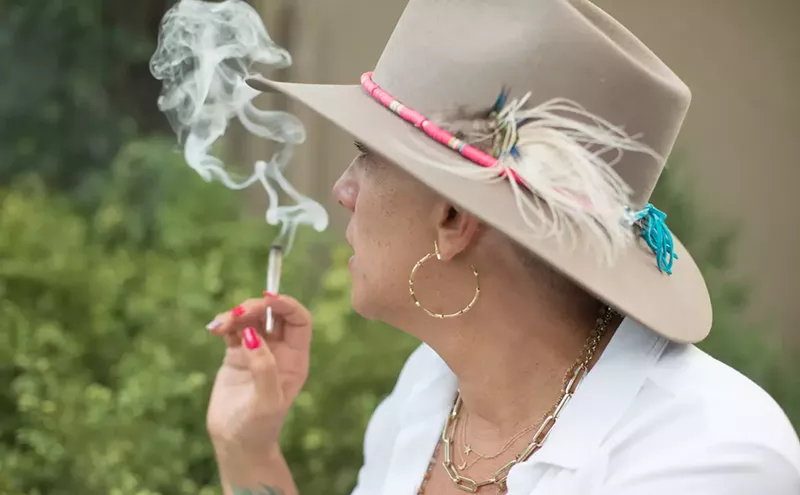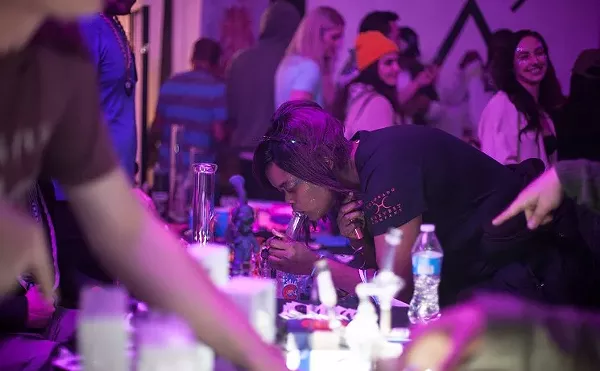Denver has no shortage of interesting streets and thoroughfares, but nothing touches the weirdness (or length) of Colfax Avenue. Full of all things odd, delicious and inebriating, Colfax attracts everyone, but it takes a certain type of character to call it home. Enter Phil Guerin, the founder of Myxed Up Creations.
Guerin dropped out of Colorado State University and moved into his parents' basement to make clay mushrooms (which are still the logo of Myxed Up), but quickly realized that glassware and smoking accessories were where the money was.Turning from mushroom purveyor to head shop owner, he began selling pieces at Myxed Up on Colfax in the early ’90s, and he hasn't looked back.
Although the shop has claimed four different Colfax addresses, Guerin never wants to leave. "It was always my desire to stay here," he says. "I love that street."
A longtime home for cannabis users and the counterculture, Myxed Up is about to celebrate thirty years on the ’Fax this October. We spoke with Guerin about all of the change he's seen since opening the shop in 1992, and what he thinks of Denver's current cannabis landscape.
Westword: What has owning a head shop been like over the decades? I imagine the laws and products you've sold have changed quite a bit.
Phil Guerin: We were here at the very beginning of what I would call the glass evolution. Denver played a really prominent role in everything that happened with that. There was a warehouse on Brighton Boulevard making around 1 million pipes per year, and this guy had a twenty-station setup for glassblowing and torches. He's since sold all of that, and Brighton Boulevard is a completely different place now, but I met him around fifteen years ago during this era. Everyone thinks the glass stuff started in Oregon, but they were producing about 1 million Pyrex pipes here in Denver at the time and then sending them to California. Everyone thought those color-changing lampwork pipes were from California, but they weren't.
The novelty items came around the late ’80s, and there were acrylic water pipes and stuff in the ’70s and early ’80s. When we first got into this with our Fimo clay pipes, that was something new. But honestly, that business remained relatively unchanged for about thirty years. It was mostly Proto Pipes, Zig-Zags, bamboo rollers, metal chamber pipes and Sneak A Tokes. The next big thing after we got into this was graphics, and we took out an ad in the back cover of High Times for a pipe catalogue we'd send out. We made like $1 from each of them, but we made thousands of dollars sending these out. We helped make that sort of thing mainstream. Everything from there has sort of evolved into the technology we see today, whether it's a Volcano [vaporizer] or Puffco Peak. Now you can't separate this industry from technology.
That reminds me of the first time I came across a Mile High Comics ad in a Spiderman comic book way back when.
It was highly effective. We took out a whole page, which was a lot of money for us back then, but we really blew it up for Colorado. We were some of the first people to celebrate 4/20 as a day. I'm not saying we invented the concept of 4/20, but that was always associated with the time 4:20 p.m., and not the day [April 20]. We started celebrating that as a customer appreciation day and as an evolution of Earth Day. There were all of these people who used to celebrate Earth Day at City Park, so we decided to incorporate 4/20 into it.
How did people respond to that idea back then?
At first people were asking us why we were celebrating Adolf Hitler's birthday, because that's on April 20. Then it was the same date as Columbine, which happened literally as we were hanging up balloons. We always had to explain that it was 4/20 to people, but then we partnered with Cervantes', and more people and our competition started stepping up for that day, too, and it started snowballing. Things like that weren't going on anywhere else but here back then. We had national brands coming in from New York and elsewhere.
What do you think of the progression that legalized cannabis has taken over the last several years?
It's sweet, because it's something I've fought for my whole life. I had to kind of watch what was happening on the sidelines, because I had a target on my back thanks to years of prohibition. I set out to normalize things and find healthier alternatives and ways to advocate health. I really feel that the way Colorado has done things here has been in a healthy way. I wish the rest of the country would catch up and allow [cannabis] banking, because it's affecting a lot of people. We're also seeing things be consolidated because these big corporations are flush with cash. Smaller entrepreneurs don't have that luxury, and a lot of the creativity we saw here ten years ago has kind of been stifled. I'd still rather have it this way than it not being legal, though, and I think we're better for it. That's not even getting into the medical benefits of marijuana.
How much has Colfax changed since you first set up there?
We were next to Casa Bonita for a while, but we had a horrible landlord, and 9/11 happened. There used to be tour buses there all the time, and I think they'll return now that Trey Parker and Matt Stone took it over. When we were on Colfax's west side, LoDo was being gentrified, and so we basically got to see all of those people pushed out in the early 2000s. It was sort of a premonition of what East Colfax would look like in a few years.
Back then, East Colfax was run by biker gangs, and there was a lot of prostitution, but there were also a lot of cops. Colfax was the hottest street in this region, and there was always attention. There was a lot of drugs and violence back then, but there was almost a street order about it. There wasn't a lot of graffiti. When Bill Clinton put cops on the streets, Colfax cleaned up a lot, and Capitol Hill basically moved east. A lot of bars opened up, and more people came. That was a positive trend all the way up to Monaco. It seems to have sort of stunted at Monaco, though.
During COVID and since, we haven't seen a lot of law enforcement on Colfax, either. I still see very little patrolling on Colfax. From the ’70s to now, this is the most lawless I've ever seen Colfax. I see motorcycles racing and doing wheelies on Colfax at, like, 5 p.m. now. It's entertaining and kinda cool, but it's also out of control.

Audio By Carbonatix
[
{
"name": "GPT - Billboard - Slot Inline - Content - Labeled - No Desktop",
"component": "23668565",
"insertPoint": "2",
"requiredCountToDisplay": "2"
},{
"name": "STN Player - Float - Mobile Only ",
"component": "23853568",
"insertPoint": "2",
"requiredCountToDisplay": "2"
},{
"name": "Editor Picks",
"component": "17242653",
"insertPoint": "4",
"requiredCountToDisplay": "1"
},{
"name": "Inline Links",
"component": "18838239",
"insertPoint": "8th",
"startingPoint": 8,
"requiredCountToDisplay": "7",
"maxInsertions": 25
},{
"name": "GPT - 2x Rectangles Desktop, Tower on Mobile - Labeled",
"component": "24956856",
"insertPoint": "8th",
"startingPoint": 8,
"requiredCountToDisplay": "7",
"maxInsertions": 25
},{
"name": "Inline Links",
"component": "18838239",
"insertPoint": "8th",
"startingPoint": 12,
"requiredCountToDisplay": "11",
"maxInsertions": 25
},{
"name": "GPT - Leaderboard to Tower - Slot Auto-select - Labeled",
"component": "17676724",
"insertPoint": "8th",
"startingPoint": 12,
"requiredCountToDisplay": "11",
"maxInsertions": 25
}
]

